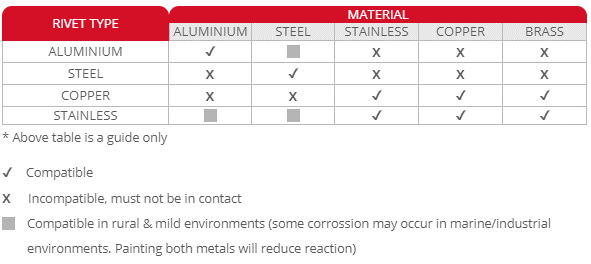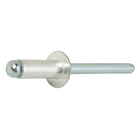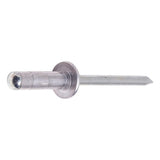Rivet Supplies - Sydney's one stop rivet shop
Looking for a rivet supplier?
Selecting the right rivet is often about hassle-free work, from motor body building workshops to security fence installers, purchasing rivets from a specialist industrial fastener supplier that understand rivets, and how they work, makes sense! For fast and smart rivet selection we have an all-in-one link on the top menu bar of our site. Rivet Dept is dedicated to all things rivets, including links to Huck® rivets, pop rivets, rivet-tool and riveting articles. So for all your rivet requirements along with rivet know-how there is only one destination - Aerobolt's Rivet Department.
Before we delve in this article, lets touch base with the basics. What is a rivet? Essentially a rivet is composed of two components, a tube & pin. The pin is normally longer than the tube and designed to be pulled up through the tube whilst enlarging it in the installation process. As the body expands it secures the material between the two ends. At a predetermined point, the pin used to pull up the body will break, and drop off. The key benefit of a rivet is; they are fast & easy to use, long-lasting,and a low-cost fastener. Rivets work well for the joining of many different types of material, including thin sheet metals, composites and so much more.
- One side assembly means fast installations, as access to the rear is not required
- Highly resilient, forming a mechanically activated permanent joining solution.
- Easy to use air, cordless, and manual rivet-tools that require minimal effort and training.
- Design flexibility, wide range of types and materials to suit most applications.
- Easy inspection and maintenance, no expensive equipment for quality control.
What are the main rivet types?
Here we list the different rivet sub-categories plus some specialised heavy duty structural rivets. There are many other different types of rivets like semi-tubular, split rivets, and solid rivets however in this article we are looking at blind rivets only. Your rivet selection should be based on the application connection you believe is required, whether your job involves installing lightweight guttering or heavy duty truck fabrication. There are numerous rivet terms for the same rivet type and in this article we have incorporated the different descriptions in the title.
General rivet types.
Open End Rivet. (Pop Rivet or Blind Rivet).
Open end rivets means the rivet body is hollow i.e., "open end tube (body)". This is the most common rivet available and the least expensive. Available in a range of materials, including steel & aluminium, all steel, all aluminium, stainless & steel, all stainless, nickel & copper. This rivet also has the widest range of different head styles, dome head, truss, or large flange and countersunk.
Closed End Rivets. (Sealed Rivets).
Sealed rivets or closed end rivets have a cup shaped end that eliminates water ingress from within the body of the rivet, but not between the outside of the body and the material. Many customers purchase sealed rivets believing they are 100% waterproof, unfortunately this perception is not entirely correct. A closed-end rivet compared to an open-end rivet of the same size & material, provides better shear and tensile strength.
Multi-Grip Rivet.
Multi-Grip rivets are a strong & highly flexible option due to their extended material grip range. The multi-grip is our strongest standard rivet choice, for many this rivet helps reduce stock options as one multi-grip rivet replaces a few different size open end rivets. This assists to reduce cost and minimise operator errors. A multi-grip rivet, compared to an open-end rivet of the same size & material, provide greater shear and tensile strength. Check the blog Multi Grip Rivet V's Open End Rivet.
Tri-Folding Rivet.
Aluminum tri-folding rivets are split or slot body rivets that are designed for the assembly of lightweight materials such as fibreglass, plastics, thin steel sheeting & composite material. This rivet forms a propeller shape anchor connection on the blind side of the material without damaging it. Tri-folding rivets are installed with the same type of rivet gun that install all other standard type rivets.
Peeled Rivet.
Peeled rivets are also ideal for the joining of softer material such as timber, plastic, rubber, fibreglass, and laminates. Upon installation, the rivet body splits into petals that bends outwards, like peeling a banana. The petals bend out and contact the blind side of the material, creating a large anchor head.
Grooved Rivet.
Grooved Rivets are designed to be installed within a hole as they infuse themselves into the material, making it ideal for soft materials such as timber, plastics & other fibrous material. When set correctly, the annular rings around the body will expand and embed into the surrounding material. This means the rivet does not require an open hole to work as it sets itself within the material.
Structural Rivet. Heavy duty industrial rivets.
Huck Rivet Magna-Lok. (Monobolt®).
Huck Magna-Lok® is a versatile structural rivet that is ideal for multiple material grip ranges. This rivet has Huck’s unique internal locking mechanism that provides a high resistance to vibration & moisture. Fast and easy to install using conventional Huck brand gun or a structural rivet gun. Aerobolt is Australia's number #1 Huck distributor with the complete range of structural rivets and structural rivet tools.

Allok® Rivet. (High Strength Rivets, Magna-Bulb® Rivets).
Allok® rivets, High Strength Rivets, and Magna-Bulb® rivets feature a double-locking system that secures the material on both sides of the panel for great strength, providing a vibration and weather resistant joint. It has a non-protruding blind side bulb that spreads the load, whilst avoiding pull-through. Easy to install via a Huck gun & other structural rivet tools as a standard rivet gun is not built to install structural rivets. This type is also known as Orlock® rivet, Hemlok® rivet or Ornit® rivet.

Tri-Bulb Rivet (Huck-Tite®, Bulb-Tite®).
Tri-Bulb rivets differs from other types due to their slot body that creates a propeller shape blind–side anchor that combines with a washer to provide a weatherproof joint. Bulb-Tite®, and Huck-Tite are other tri-folding split body rivet that spread their clamping force through the anchor blades whilst providing excellent pull through resistance, making them an ideal choice for lightweight panel applications, humid conditions, or where water might be an issue.

One stop industrial supply solution
Are you looking for one supplier to meet your fastening needs? With over 30 years’ experience in supplying the very best fastening and assembly solutions from industry leading brands. You will find Aerobolt can help with a comprehesive range of industrial supplies from leading manufacturers.
How do I select the right rivet?
Rivet selection is easy, you will need to consider rivet material, rivet diameter size, and thickness of the material you are riveting.
Rivet Material.
The rivet is categorised by the material of the body and then the material of the pin. For example, you might see “aluminum/steel”, which means an aluminum body with a steel pin. These fasteners typically come in steel, stainless steel, or aluminum or in a combination of these materials.
Rivet material type provide a good guide to their strength. As a general rule; an aluminium body with aluminium pin is not very strong; aluminium body with steel pin are a a little stronger; steel body with steel pin are stronger still; and stainless-steel body with either steel or stainless-steel pin are the strongest. Use steel rivets for heavy duty applications and aluminium rivets for lightweight jobs.
Ensure the rivet material is compatible with the material being joined to avoid galvanic corrosion. Avoid using aluminium and stainless steel together, we recommend keeping the material like for like for maximum life. Stainless with stainless, aluminium with aluminium, etc. When reviewing material, you will also need to consider environmental factors, such as extreme temperatures or salt sprays. See the table below as a general guide.

Pop Rivet Diameter & Hole Size.
Rivet diameter selection is guided by the material gauge, for instance use small diameter rivets with lightweight fascia covers and larger diameter rivets in the fabrication of tool boxes. The larger the diameter the stronger the rivet as a general rule the rivet diameter should be about three times the thickness of the thickest piece of joined material.
Drill hole size is also important. If the rivets diameter is too small for its hole the fastener will fail. Referring to the hole diameters before drilling is an easy way to avoid issues later.
Refer to the table below covering diameters and corresponding hole sizes.

Rivet Material Grip Range.
The material grip range refers to the material thickness or the depth the rivet can be effectively installed. For example, if two 1.5 mm plates/items need to be riveted, a blind rivet with a material grip range between 2- 5 mm is required. Best practice means that the middle grip range of a rivet should be what you aim for then minimum followed by the maximum. This assists in achieving correct shear and tensile strength whilst ensuring the longevity of the rivet. Please note that the grip range is not the length of the rivet as many people mistakenly believe the length is the amount of material the rivet will pull up.
WARNING; If you are below the minimum grip range the rivet will be loose and if you are over the maximum, the rivet may not set correctly. Either way the joint will be compromised.
Listed below we have a table listing standard blind rivet material grip ranges and their corresponding grip code.

Rivet Head Type.
Rivet head assists in holding the material together and enhances its appearances. Dome head is shaped like a small portion of a ball that sits proudly above the material, whilst the large flange or truss head is a shallower broader profile. The large flange or truss head has double the bearing area of the dome head which makes it ideal when fastening rubber, plastics or fibreglass as the head has greater coverage. The countersunk option provides a flush neat finish subject to countersinking a hole first, allowing for the head to sit level with the surrounding material. The image below covers the typical head types plus a few specialised rivet type profiles.

Pop rivet Vs blind rivet.
This is a common customer inquiry. The answer is simple there is no difference between pop rivet, and blind rivet. These are different rivet terms for the same item, a blind rivet means you do not need access to the other side of the material, or you can't see the other side of the material. Also known as pop rivets because this is the name of the original rivet company-Pop® and this is the sound rivets make upon installation.
Frequently Asked Pop Rivet Questions.
How do I order rivets?
There are number of different type of rivet code formats. At Aerobolt we use the same product code as "Marson® Rivets" which is a division of Howmet Aerospace. Rivet code begins with the "body material", followed by the "head type","body diameter" dash & then "grip range" (both of which are representive numbers, rather than actual measurements). The code concludes with the pin material. Understanding codes avoids issues later on.

In the above product code example (in the red box), beginning from left to right we have:
A = Aluminium body material. Other options include (S = Steel, SS = Stainless, etc.).
B = Button / Dome Head. Or you can select (T/LF = Truss/Large Flange, C = Countersunk)
6 = 4.8mm (3/16") body diameter. Other options are; 4 = 3.2mm (1/8"), 5 = 4.0mm (5/32"), 8 = 6.4mm (1/4").
6 = 7.9 - 9.5mm this is the material grip range. See grip codes number table in previous section.
S = Steel pin/mandrel material. The other options are (SS = Stainless, A = Aluminium etc.).
How do I remove a pop rivet?
Rivet removal is straight forward with the right tools. This requires the destruction of the rivet, and the best method is to drill it. You will need, a drill, drill bit, long nose pliers, & safety accessories such as glasses and gloves.
Steps: Use your safety glass & gloves before starting the drilling process. Place the drill bit against the rivets’ center pin and drill through the body at a low but steady speed. Once drilling is completed, pull the rivet off with your long nose pliers. How easy was that!
How do I install a rivet?
To install a rivet is simple with practice, pre drilling of holes is required. Load rivet’s pin tail section into rivet gun. Insert rivets body into hole and activate gun. Upon activation the head of the rivet is pushed against the outer surface of the tool, whilst the tool pulls up the central pin. As a result, the bottom portion of the rivet compresses, and expands on the blind side. This expansion increases until it reaches approximately one and a half times the size of the original diameter. Resulting in a larger surface in which the two materials are effectively fastened together.
How does a pop rivet work?
How rivets work is ingenious. Essentially a rivet is composed of two components, a metal tube (body) & pin (mandrel). The pin is normally longer than the tube and designed to be pulled up through the tube whilst enlarging it in the process. This results in the expanded tube clamping the material between the two ends of the tube. See the image below to better understand how a rivet works.

Which is the best rivet gun?
Selecting the correct rivet gun depends on several factors that relate to your specific requirements, rivet gun section is covered in the blog; Ultimate Guide to Rivet Guns.
Which is the strongest rivet?
Structural blind rivets are the strongest option on the market due to the unique combination of internal pin retention & locking mechanism that creates their inner strength. Aerobolt has the complete Huck Structural Rivet range including the original multi-grip rivet "Magna-Lok", the Huck Rivet "Magna-Bulb" with its superior installation values and the hybrid of the two "Hucklok Rivet". The strongest structural rivet option is Huck Rivet "Magna-Bulb" refer to the table below to compare a range of structural rivet test lab results.
| STRUCTURAL RIVET TYPE | KEY LAB METRICS FOR STEEL 6.4MM (1/4") | |||
| Shear Typ. (kN) | Tensile Typ. (kN) | Grip Range (mm) | ||
| Magna-Lok® (HRDS-0806) | 11.1 | 8.2 | 2.0 – 9.5 | |
| Hucklok® (HKLP-R8-6) | 15.6 | 8.5 | 2.0 – 9.5 | |
| Magna-Bulb® (MBDS-0806) | 16.0 | 8.9 | 5.8 – 7.8 | |
| Allok® (ARDS-08145) | 13.7 | 7.9 | 5.0 – 8.5 | |
Can I get coloured pop rivets?
Yes, painted rivets are available. They cost a little extra compared to the mill(raw) finish and are available in a wide range of colours. Refer to the Colorbond ® colour chart for your selection.
When is it better to use a rivet rather than a bolt and nut?
Bolts & nuts offer a useful combination of strength & convenience, and are an ideal solution in static applications i.e. where movement is at a minmum. The disadvantage of these fasteners is their poor resistance to vibration, this means over time they will loosen and lose their grip. Huck bolts and Huck's structural rivets overcome this issue, so in this instance the right answer is in the application.
Who invented the pop rivet?
In 1934 the George Tucker Eyelet Company was approached by an aircraft manufacturer to develop a fastener that could be set from just one side of the material. This lead to the world famous POP® rivet—named for the “popping” sound it makes during installation—Pop® is now owned by Stanley Black & Decker.
Why are rivets used on airplanes?
Rivets are preferred for the construction of airplanes because they can withstand extreme stress. They are said to withstand extreme stress without breaking and they hardly succumb to damage. They are used in aerospace manufacturing because it simplifies both production and maintenance. Another reason why rivets are used because aluminium materials used are intolerable to heat.
Do you deliver rivets throughout Australia?
Yes, we can deliver Australia wide through our network team of courier companies. In Sydney we offer our customers same day delivery if you order before 10.00am or the next day. Deliveries to regional New South Wales or major Australian cities such as Melbourne, Brisbane including regional South Eastern Australia are either next day delivery or 2 days turnaround.
The Wrap.
Rivets offer superior fastening capabilities for both heavy-duty and light fabrication applications. Wherever there is a construction site or a fabrication workshop there is bound to be a rivet in use. Irrespective of the rivet type you can be assured with a bit of planning and with the assistance of Aerobolt® your job will be successful. We are one of Sydney's leading rivet supplier with a comprehensive range of general rivets plus industrial strength structural rivets along with a wide range of rivet guns. You can reach out to us by either telephoning us on 02 9755 3747 or email via the contact us page.





